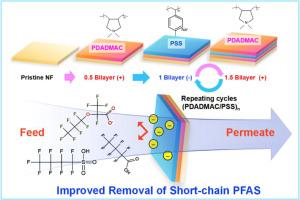Enhancing rejection of short-chain per- and polyfluoroalkyl substances by tailoring the surface charge of nanofiltration membranes
IF 11.4
1区 环境科学与生态学
Q1 ENGINEERING, ENVIRONMENTAL
引用次数: 0
Abstract
Nanofiltration (NF) effectively removes per- and polyfluoroalkyl substances (PFAS) from water but struggles with short-chain PFAS (i.e., those containing less than 6 perfluorinated carbons) due to size exclusion inefficiency. In this study, we developed layer-by-layer assembled NF membranes with PDADMAC/PSS terminal bilayers varying in chain lengths, hydrophilicity, and charge, and systematically assessed their removal of 16 representative PFAS species. The mechanisms between long-chain and short-chain PFAS were investigated and optimal strategies for enhancing PFAS selectivity were developed. Results demonstrated that the (PDADMAC/PSS)3 membrane achieved the highest removal (86.1%-98.1%) for short-chain PFAS, including PFBA-PFHpA (C4-C6), PFBS (C4), PFMOPrA (C3), PFMOBA (C4), and GenX (C5), while effectively removing (>99.9%) long-chain counterparts (≥C7). As feed water pH increased from 3.5 to 9.0, average PFAS rejection rose from 16.6% to 32.0%, revealing more negative charged membrane surface endow stronger electrostatic repulsion, particularly for short-chain anionic PFAS. In addition, we also tested the PFAS removal efficacy of (PDADMAC/PSS)3 membrane using real sewage plant effluent. Compared to the pristine membrane, the (PDADMAC/PSS)3 membrane exhibited improved removal for most PFAS, with removal efficiencies ranging from 82.5% for PFOA to 96.7% for PFOS. The most significant improvements were observed in C4 compounds like PFBA and PFBS (increased by 6.0-11.5%). Our study suggests that PFAS removal efficiency by NF highly depends on size exclusion, with short-chain anionic PFAS more likely affected by electrostatic repulsion. Membrane surface manipulation can enhance selectivity, aiding in predicting NF treatment effectiveness for specific PFAS compounds.


通过调整纳滤膜表面电荷来增强对短链全氟烷基和多氟烷基物质的截留
纳滤(NF)可以有效地去除水中的全氟烷基和多氟烷基物质(PFAS),但由于尺寸排除效率低下,短链PFAS(即含有少于6个全氟化碳的物质)难以去除。在这项研究中,我们开发了具有不同链长、亲水性和电荷的PDADMAC/PSS末端双分子层的层层组装NF膜,并系统地评估了它们对16种代表性PFAS的去除效果。研究了长链PFAS与短链PFAS的作用机理,提出了提高PFAS选择性的最佳策略。结果表明,(PDADMAC/PSS)3膜对PFBA-PFHpA (C4- c6)、PFBS (C4)、PFMOPrA (C3)、PFMOBA (C4)和GenX (C5)等短链PFAS的去除率最高(86.1%-98.1%),对长链PFAS (C7-8)的去除率最高(99.9%)。随着给水pH从3.5增加到9,平均PFAS截留率从16.6%增加到32.0%,表明膜表面负电荷越多,静电斥力越强,特别是对短链阴离子型PFAS。此外,我们还利用真实的污水厂出水测试了(PDADMAC/PSS)3膜对PFAS的去除效果。与原始膜相比,(PDADMAC/PSS)3膜对PFOA的去除率在82.54% ~ 96.71%之间。最显著的改善是C4化合物,如PFBA和PFBS(增加6.0-11.5%)。我们的研究表明,NF去除PFAS的效率高度依赖于尺寸排除,短链阴离子PFAS更容易受到静电排斥的影响。膜表面操作可以提高选择性,有助于预测NF对特定PFAS化合物的处理效果。
本文章由计算机程序翻译,如有差异,请以英文原文为准。
求助全文
约1分钟内获得全文
求助全文
来源期刊

Water Research
环境科学-工程:环境
CiteScore
20.80
自引率
9.40%
发文量
1307
审稿时长
38 days
期刊介绍:
Water Research, along with its open access companion journal Water Research X, serves as a platform for publishing original research papers covering various aspects of the science and technology related to the anthropogenic water cycle, water quality, and its management worldwide. The audience targeted by the journal comprises biologists, chemical engineers, chemists, civil engineers, environmental engineers, limnologists, and microbiologists. The scope of the journal include:
•Treatment processes for water and wastewaters (municipal, agricultural, industrial, and on-site treatment), including resource recovery and residuals management;
•Urban hydrology including sewer systems, stormwater management, and green infrastructure;
•Drinking water treatment and distribution;
•Potable and non-potable water reuse;
•Sanitation, public health, and risk assessment;
•Anaerobic digestion, solid and hazardous waste management, including source characterization and the effects and control of leachates and gaseous emissions;
•Contaminants (chemical, microbial, anthropogenic particles such as nanoparticles or microplastics) and related water quality sensing, monitoring, fate, and assessment;
•Anthropogenic impacts on inland, tidal, coastal and urban waters, focusing on surface and ground waters, and point and non-point sources of pollution;
•Environmental restoration, linked to surface water, groundwater and groundwater remediation;
•Analysis of the interfaces between sediments and water, and between water and atmosphere, focusing specifically on anthropogenic impacts;
•Mathematical modelling, systems analysis, machine learning, and beneficial use of big data related to the anthropogenic water cycle;
•Socio-economic, policy, and regulations studies.
文献相关原料
公司名称
产品信息
麦克林
poly(sodium 4-styrenesulfonate) (PSS)
麦克林
polyethylene glycol (PEG)
麦克林
poly(sodium 4-styrenesulfonate) (PSS)
麦克林
polyethylene glycol (PEG)
麦克林
poly(sodium 4-styrenesulfonate) (PSS)
麦克林
polyethylene glycol (PEG)
阿拉丁
polyethylene glycol (PEG)
阿拉丁
polyethylene glycol (PEG)
阿拉丁
polyethylene glycol (PEG)
 求助内容:
求助内容: 应助结果提醒方式:
应助结果提醒方式:


